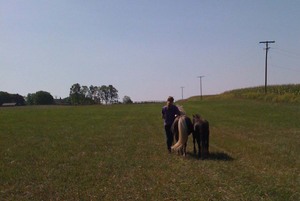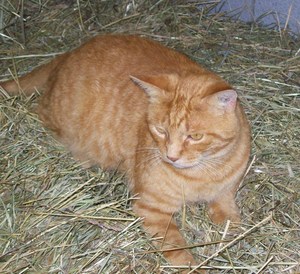'Make hay while the sun is shining' is not just an old saying - it's good advice for harvesting quality horse feed

Girl and ponies walk across hay field, shortly after first cut of hay harvested.
Kathy Lundberg | Contributor
Forage is the veggie matter horses and other livestock eat. Originally, forage referred to the plants the livestock walked about and grazed upon, or the act of going around collecting or grazing. Forage has come to refer to hay and silage as well.
Hay is cut, sun-cured grass and/or legume mixture which is preserved by drying. Silage is high-moisture, green plant matter which has been preserved by fermentation. Silage is mainly used for cattle in this country, but modern methods of forage material baled and wrapped in plastic have been advocated for horse use as well.
Some grasses thrive in cool weather, and grow quickly in the spring. These grasses die down to brown dormancy in the hot dry summer, and come back to life a bit in the cooler but shorter days of fall. In Michigan, the main varieties are orchard grass (seed heads in multiple little clumps), timothy (has the seed heads that look like caterpillars), rye grass (seed heads come in neat little braids), and fescue (small fluffy seed heads - used a lot in lawn grass). Horses love cool season grasses. Notable exception: tall fescue, which horses tend to find less palatable and can also carry an endophyte (an internal plant fungus) which can make them sick.
Warm season grasses are Bermuda grass (seed heads spray out in different directions like fireworks) and brome (elegant, elliptical seed heads) are tougher and more drought resistant.
Hayfields are commonly planted with legumes. Legumes are plants with seed pods that split into two halves. Common legumes consumed by horses are alfalfa (pretty purple flowers), clover (we all know what these look like — blooming in white pink or red), and birdsfoot trefoil (little yellow flowers).
Many related legumes are consumed by people such as beans, peas, lentils and peanuts. These are plants are good sources of protein, good low-glycemic-index carbohydrates, essential micronutrients, and fiber. Legumes pull nitrogen from the air vie their root nodules, decreasing the fertilizer requirement for a productive field.
Hay fields are generally planted with a variety of grass species so the animal receives a healthy, varied diet, and there will always be something growing. In the course of the year the same field will have different dominant species.
Over years some species will out-compete others, and you will not have the same mixture originally planted. Weed seed blows in from all around, adding to the ever-changing chorus.
In Michigan, we are currently in first-cut hay harvest season. Hay is generally cut just as the dominant species are going to seed. If you harvest too early, you will have less yield for the same amount of fuel invested. The plants will have more non-structural carbohydrates (making it more tasty to horses) but less structural integrity, and be prone to crumble once dry.
In years such as this, with a very wet spring, you may not be able to harvest at the optimal time due to wet fields. A large tractor stuck in the mud is inconvenient to say the least.
If the harvest is later than optimal, the plants become more stalky — less palatable and actually less digestible, as the plant builds non-structural carbohydrates, using the sun’s energy, into bigger structural carbohydrates which help it stand up straight. Timing of harvest is critical!
“Make hay while the sun is shining.” I never realized how true this saying is until I found myself a hay farmer.
Sunshine facilitates a complex, poorly-understood curing process in the cut plants, producing hay. The process is more than simple drying, although this is an important part. The water content of the grass must go from about 85 percent to less than 18 percent. If this level of drying is not achieved, mold and fermentation will spoil the hay.
Ideally, you need three days of dry sunshine to make hay. The time of day hay is cut is related to the amount of non-structural carbohydrates and hence its quality. This point is controversial, but many feel it is best to harvest hay in the afternoon of a sunny day.
The next day the hay may be tedded — fluffed up and turned over to promote drying. On the afternoon of the third day, the cut hay is harvested — compressed into bales of various size and tied with twine. If the air is dry, the process may be done in two days.
If it actually rains on the downed hay, its quality may suffer greatly, as nutrient composition degrades and mold can set in, ruining it. I find myself anxiously assessing the sky and the weather channel during hay harvest time and am seriously relieved when a good harvest is safely stowed in the barn.

Handsome barn cat Conrad rests in the hay, vigilant for mice.
Kathy Lundberg | Contributor
After the hay has been successfully cut and baled, storage conditions also affect quality. Hay should ideally be stored inside, away from the elements. Bales must be packed tightly into the barn with minimum of air to deter mold.
Stacked hay actually heats up after storage. The heat may cause decomposition of nutrients, and even the dreaded spontaneous combustion. Too-high moisture content increases this risk. The barn roof can afford no leaks, as a small drip over time promotes mold and rot.
One does not like to share one’s hay barn with the other creatures of the earth. Pigeons like the coziness of barns, but they create a revolting mess over time. Raccoons spread scat which can carry disease. A notable exception is the hearty barn cat with a taste for mice.
This is a brief summary of first cut hay. Second cut hay is the subject of another day. Hay is complex stuff!
Kathy Lundberg is a regular pets contributor for AnnArbor.com, and owner of Scio Church Stables. Email her at scs@sciochurchstables.com.


Comments
Trumpet
Thu, Jun 9, 2011 : 1:26 p.m.
A very informative article. Haying is a beautiful thing to watch, and the smell of new mown hay is intoxicating.....even better than just mowed grass. Washtenaw County has many hay fields and the next time we have 3 or 4 good days, I'm sure we'll see the farmers out cutting, fluffing, and baling.